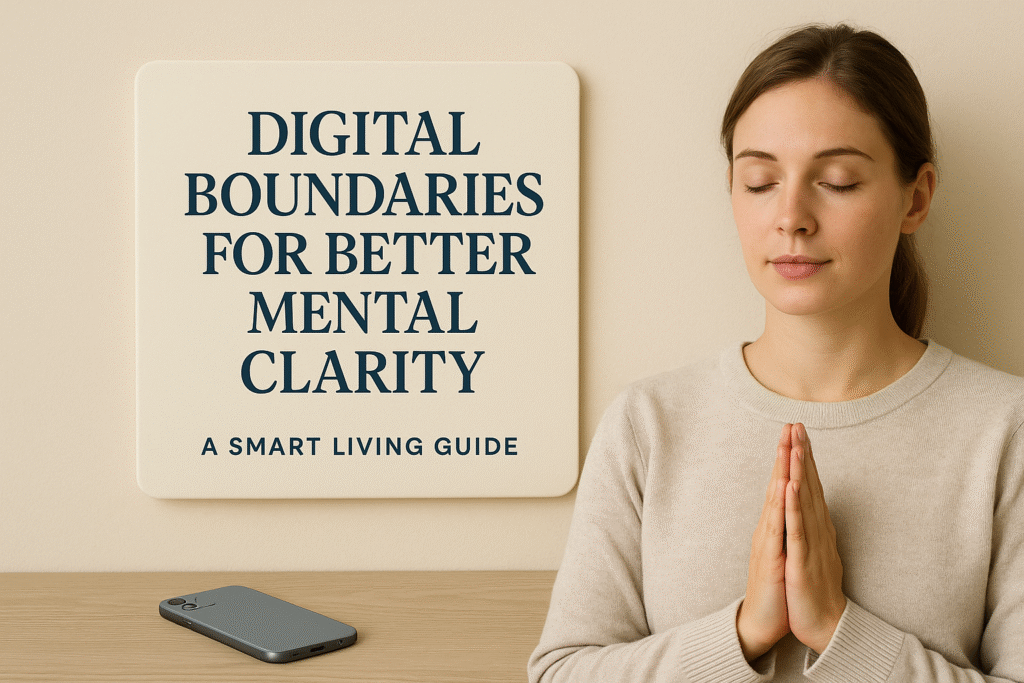
I was writing in my notebook—thoughts flowing, pen moving—when I felt it: a notification. Not on my phone, but on my mind. That’s how deep the infatuation had gone.
Even without my phone nearby, my attention flickered. My focus was hijacked by something invisible.
That moment revealed the truth: I wasn’t just distracted—I was digitally overwhelmed.
It wasn’t about deleting all my apps or going off-grid. What I needed was digital boundaries—some life changing habits that protect mental clarity and give my brain space to breathe.
What Are Digital Boundaries?
Digital boundaries are conscious limits you set on your screen time, notifications, and digital engagement.
They’re not about cutting off from the digital world, they’re about engaging with it mindfully. Think of them as gentle guardrails to help you:
- Stay focused on what matters,
- Reduce unnecessary screen time, and
- Improve mental clarity and emotional balance.
Why We Need Digital Boundaries (Backed by Research)
Constant exposure to screens and notifications fragments our attention.
It leads to cognitive overload, anxiety, and mental fatigue—even when we don’t realize it.
Attention Restoration Theory (ART)
According to researchers Rachel & Stephen Kaplan, our brains restore focus best through soft fascination—like nature, quiet, or mindful reflection.
This theory shows that true mental clarity comes when we give our attention a break from constant stimulation.
When I started practicing small tech-free moments (even just 10 minutes outdoors or with a notebook), my focus, mood, and sleep all improved.
5 Digital Boundaries That Changed My Life
These small shifts helped me protect my energy and sharpen my mind—without needing a full digital detox.
1. No Screens for the First & Last 30 Minutes of the Day
Earlier, I used to grab my phone the moment I woke up and scroll mindlessly through social media or messages. It felt like a harmless habit, but it often set a rushed or distracted tone for the rest of the day. Now, I’ve made it a point to stay off screens for the first and last 30 minutes of my day.
Instead, I use that time to stretch, reflect, plan, or simply enjoy a few quiet moments. It’s made a huge difference in how calm and focused I feel.
2. Turn Off Non-Essential Notifications
I used to get bombarded with notifications all day—likes, random app updates, sale alerts—you name it. Every buzz pulled my attention away, even when it wasn’t important. Eventually, I realized how much mental space it was eating up. So, I went through my settings and turned off all non-essential notifications.
Now, only the important stuff gets through, and my mind feels way less cluttered.
3. Create a Device-Free Zone
I’ve noticed that I’m constantly on my phone—even while eating or doing simple tasks like folding laundry or tidying up. It’s like my hands and eyes always need to be busy with a screen.
That’s why I’ve decided to create a device-free zone, especially around the dining area and during certain activities. Meals should be about being present—tasting the food, connecting with people around me, or just giving my mind a break. By keeping my phone out of reach during these moments, I’m learning to be more mindful and enjoy the little things without constant digital noise.
4. Set a “Do Not Disturb Hour” for Creative Flow
I’ve started giving myself one dedicated hour a day where all devices go silent—no pings, no vibrations, no screens. I call it my “Do Not Disturb Hour.” During this time, I dive into something that sparks creativity or focus—writing, drawing, planning, or just thinking without distraction.
It’s amazing how much clarity and inspiration can come when my mind isn’t interrupted by a constant stream of notifications. This one hour feels like a mental reset button, and it’s become something I genuinely look forward to every day.
5. Turn Boredom into a Breakthrough
Whenever I felt even a hint of boredom—waiting in line, sitting alone, or just having a quiet moment—I’d instinctively reach for my phone. Scrolling became my go-to escape.
Now, instead of grabbing my phone, I use those moments to do something small but meaningful—like journaling a quick thought, doing a few stretches, observing my surroundings, or simply letting my mind wander. It’s in these quiet pockets of time that some of my best ideas and reflections surface. Boredom doesn’t have to be filled—it can be freeing.
Your Mind Deserves Quiet, Too
You don’t need to disappear. You just need to disconnect enough to reconnect.
- Leave your phone in another room for an hour.
- Go for a short walk with no podcasts or music.
- Go for a short walk with no podcasts or music.
Notice how it feels when your attention is yours again.
Final Thought:
That day in my notebook, when my mind lit up with the ghost of a notification—it felt like a wake-up call.
I was devoting my attention to everything but myself.
Now I protect it like energy.
Because attention is not just focus.
It is devotion, and it deserves to be sacred.
Before You Go…
If this post sparked a moment of clarity, imagine what a week of mindful choices could do.
Subscribe to the Smart Living Letter — one short, thoughtful email every week to help you live less distracted, more intentional.
No noise. Just clarity, calm, and conscious living.
Meditation has also helped me create space for clarity.
[Here’s how I use it in daily life.]”

